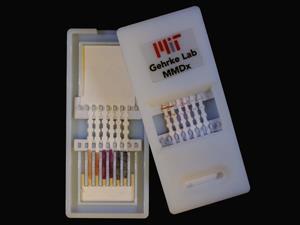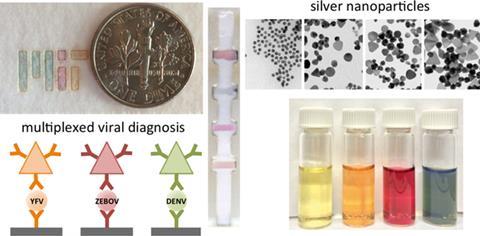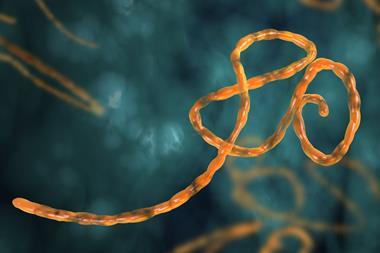Lateral flow test checks for Ebola, yellow fever and dengue in one go

Researchers in the US have developed a silver nanoparticle-based paper test to simultaneously detect dengue, yellow fever and Ebola. This could provide a cheap and reliable diagnosis for all three diseases, that’s as quick as a home pregnancy test.
The Ebola epidemic in West Africa underscores an urgent need for rapid diagnostics; quick identification and patient isolation can benefit the sick and the healthy. However, dengue, yellow fever and Ebola all initially manifest as a fever and headache, so are easily mixed up.
Now, this huge problem has a tiny solution – an 8×3cm lateral flow test. Lee Gehrke and his team at the Massachusetts Institute of Technology and Harvard Medical School adapted the traditional single marker lateral flow test to diagnose several diseases at once. It costs $2 (£1.30), takes 10 minutes, and there is no need for a power supply, trained specialist or expensive equipment.
The test is made from strips of paper containing antibodies attached to triangular silver nanoparticles of varying size according to the disease they recognise and bind to. Silver nanoparticles appear as different colours according to their size, so when a patient’s serum sample migrates through the device, distinctive coloured lines appear on the paper to indicate positive results for Ebola, dengue or yellow fever. This pattern of lines can be analysed by eye but the team are also working on a mobile phone application to aid diagnosis. ‘An app could be very useful for diseases that are mosquito-spread,’ says Gehrke. ‘It adds a date and geographical stamp to the test results so the spread of disease can be followed in real-time.’

Warren Chan, an expert in nanomaterials-based diagnostics at the University of Toronto in Canada, sees the research as an exciting step forward: ‘They have solved the immense problem of detecting multiple disease targets at the same time. The next step will be to clinically validate the technology.’
Gehrke’s team are now testing the device in both field and clinical studies, and plan to adapt it to diagnose a wider range of viruses.
References
This article is free to access until 31 March 2015. Download it here:












No comments yet